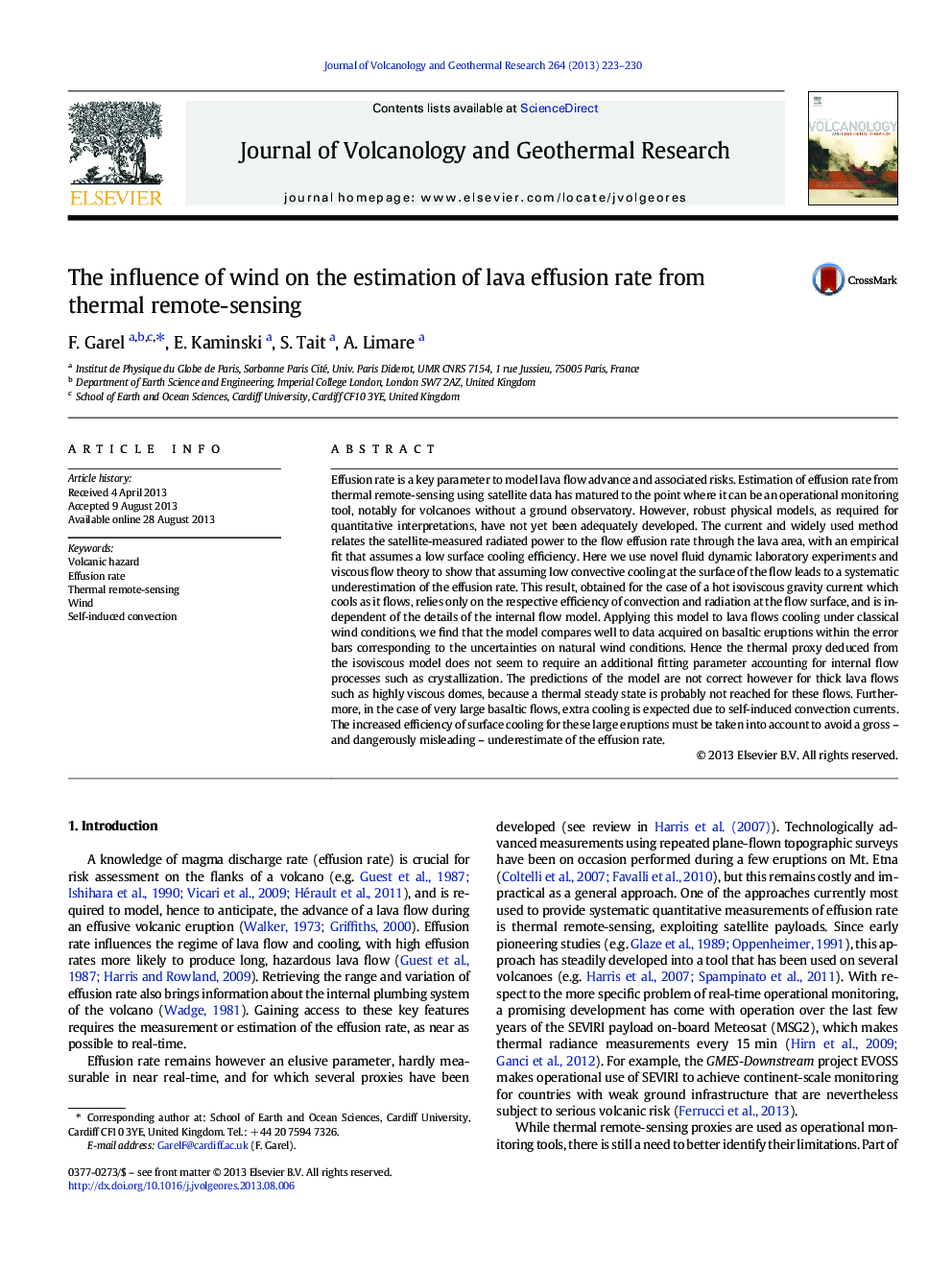| کد مقاله | کد نشریه | سال انتشار | مقاله انگلیسی | نسخه تمام متن |
|---|---|---|---|---|
| 6440125 | 1638357 | 2013 | 8 صفحه PDF | دانلود رایگان |
عنوان انگلیسی مقاله ISI
The influence of wind on the estimation of lava effusion rate from thermal remote-sensing
ترجمه فارسی عنوان
تأثیر باد بر برآورد نرخ خروج گدازه از حسگر دور سنجی حرارتی
دانلود مقاله + سفارش ترجمه
دانلود مقاله ISI انگلیسی
رایگان برای ایرانیان
کلمات کلیدی
خطر آتشفشان نرخ انفجار، حرارتی از راه دور سنجش، باد، کنجکاوی با خود،
ترجمه چکیده
نرخ تبخیر یک پارامتر کلیدی برای پیشبرد جریان گدازه و خطرات مربوط به آن است. برآورد نرخ افیوژن از سنجش از راه دور با استفاده از داده های ماهواره ای به نقطه ای رسیده است که می تواند ابزار نظارت عملیاتی باشد، مخصوصا برای آتشفشان ها بدون رصدخانه زمین. با این حال، مدل های فیزیکی قوی، همانطور که برای تفسیرهای کمی مورد نیاز است، هنوز به اندازه کافی توسعه نیافته اند. روش فعلی و به طور گسترده ای استفاده می شود قدرت تابش اندازه گیری ماهواره ای به نرخ جریان خروج از طریق منطقه گدازه، با استفاده از تجربی که فرض می شود بهره وری خنک کننده سطح پایین است. در اینجا از آزمایشات آزمایشگاهی دینامیکی مایع جدید و تئوری جریان چسبناک استفاده می کنیم تا نشان دهد که فرض بر این است که خنک کننده کنترلی کم در سطح جریان، منجر به کم توجهی سیستماتیک نرخ افیوژن می شود. این نتیجه به دست آمده برای یک جرم گرانش گرم داغ که جریان آن را سرد می کند، فقط به کارایی مربوط به کنجکاوی و تابش در سطح جریان بستگی دارد و مستقل از جزئیات مدل جریان جریان داخلی است. با استفاده از این مدل برای خنک کردن جریانهای گدازه تحت شرایط باد کلاسیک، ما دریافتیم که مدل با اطلاعاتی که در مورد فوران بازالتی در میله های خطا مطابقت دارد با عدم اطمینان در شرایط باد طبیعی، به خوبی قابل مقایسه است. از این رو، پروکسی حرارتی حاصل از مدل ایزواسیز، به نظر نمی رسد نیاز به یک پارامتر انطباق اضافی برای حسابداری جریان های داخلی مانند کریستالیزاسیون داشته باشد. پیش بینی های مدل درست نیست اما جریان های گدازه ضخیم مانند گنبدهای بسیار چسبناک، چرا که یک حالت پایدار حرارتی برای این جریان ها امکان پذیر نیست. علاوه بر این، در مورد جریانهای بسیار بازالتی، انتظار می رود که خنک کننده اضافی به علت جریان های کنتاکتی خود منجر شود. افزایش بهره وری از خنک کننده سطح برای این فوران های بزرگ باید مورد توجه قرار گیرد تا اجتناب ناپذیر و گمراه کننده به خطر بیفتد.
موضوعات مرتبط
مهندسی و علوم پایه
علوم زمین و سیارات
ژئوشیمی و پترولوژی
چکیده انگلیسی
Effusion rate is a key parameter to model lava flow advance and associated risks. Estimation of effusion rate from thermal remote-sensing using satellite data has matured to the point where it can be an operational monitoring tool, notably for volcanoes without a ground observatory. However, robust physical models, as required for quantitative interpretations, have not yet been adequately developed. The current and widely used method relates the satellite-measured radiated power to the flow effusion rate through the lava area, with an empirical fit that assumes a low surface cooling efficiency. Here we use novel fluid dynamic laboratory experiments and viscous flow theory to show that assuming low convective cooling at the surface of the flow leads to a systematic underestimation of the effusion rate. This result, obtained for the case of a hot isoviscous gravity current which cools as it flows, relies only on the respective efficiency of convection and radiation at the flow surface, and is independent of the details of the internal flow model. Applying this model to lava flows cooling under classical wind conditions, we find that the model compares well to data acquired on basaltic eruptions within the error bars corresponding to the uncertainties on natural wind conditions. Hence the thermal proxy deduced from the isoviscous model does not seem to require an additional fitting parameter accounting for internal flow processes such as crystallization. The predictions of the model are not correct however for thick lava flows such as highly viscous domes, because a thermal steady state is probably not reached for these flows. Furthermore, in the case of very large basaltic flows, extra cooling is expected due to self-induced convection currents. The increased efficiency of surface cooling for these large eruptions must be taken into account to avoid a gross - and dangerously misleading - underestimate of the effusion rate.
ناشر
Database: Elsevier - ScienceDirect (ساینس دایرکت)
Journal: Journal of Volcanology and Geothermal Research - Volume 264, 15 August 2013, Pages 223-230
Journal: Journal of Volcanology and Geothermal Research - Volume 264, 15 August 2013, Pages 223-230
نویسندگان
F. Garel, E. Kaminski, S. Tait, A. Limare,
